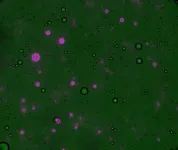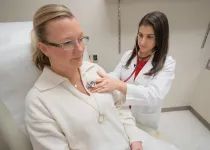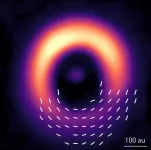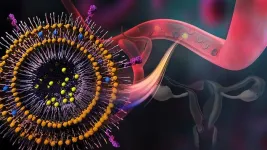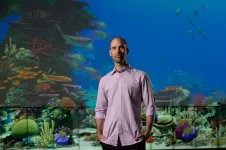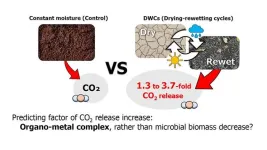One leading theory on the origins of life on Earth proposes that simple chemical molecules gradually became more complex, ultimately forming protocells—primitive, non-living structures that were precursors of modern cells. A promising candidate for protocells is polyester microdroplets, which form through the simple polymerisation of alpha-hydroxy acids (αHAs), compounds believed to have accumulated on early Earth possibly formed by lightning strikes or delivered via meteorites, into protocells, followed by simple rehydration in aqueous medium. A recent study from the Earth-Life Science Institute (ELSI) at Institute of Science Tokyo provides new evidence supporting the formation of polyester microdroplets under a wider range of realistic prebiotic conditions than previously thought.
Led by PhD student Mahendran Sithamparam of the Space Science Center (ANGKASA), Institute of Climate Change, National University of Malaysia as the first author and co-supervised by ELSI's Specially Appointed Associate Professor Tony Z. Jia and ANGKASA Research Scientist Kuhan Chandru, the study explored the formation of these microdroplets under conditions more reflective of early Earth. The team found that polyester microdroplets could form even in salt-rich environments, at low αHA concentrations, and in small reaction volumes. This expands on previous research, which primarily considered their formation at high concentrations or in larger bodies of water such as coastal areas of lakes or hot springs. The findings suggest instead that polyester protocells were likely more widespread than previously thought, potentially forming in confined spaces like rock pores or even in high-salt environments such as briny pools or oceanic environments.
In 2019, the research team discovered that polyester microdroplets could form through a simple dehydration process. When gently heated to 80°C, phenyllactic acid (PA), a type of αHA, transitioned into a gel-like substance that subsequently formed membraneless droplets when rehydrated. In their latest study, the researchers investigated whether these microdroplets could form under more dilute or lower volume conditions, similar to those expected on prebiotic Earth. "Earlier laboratory tests often used high initial concentrations and volumes of αHAs in the hundreds-of-millimolar or microliter range, respectively, which may not reflect the conditions on prebiotic Earth, where such conditions were unlikely; this is why we needed to push the limits of the polymerisation droplet assembly processes to see whether assembly of such protocells would have actually been viable on early Earth," explains Jia.
To simulate these more realistic conditions, the researchers reduced the concentration and volume of PA in synthesis and subsequent droplet formation studies. They found that polyesters could be synthesised and droplets could form with as little as 500 µL of 1 mM PA or 5 µL of 500 mM PA. This suggests that polyester microdroplets could have naturally emerged both in confined spaces, such as rock pores, or dilute environments, such as those following flooding or precipitation.
To further test real-world conditions, the team simulated reactions in salinities resembling those in the ancient ocean. They introduced 1M NaCl, KCl, and MgCl2 to the PA reactants, finding that polyester synthesis and microdroplet assembly could proceed in NaCl and KCl but not in MgCl2. This suggests that polyester microdroplets would have been more likely to form in water bodies with specific salt compositions, such as those high in NaCl and KCl but low in MgCl2, favourable to αHA polymerisation and subsequent polyester microdroplet assembly. "The conclusions of this study clearly show that polyester protocells were likely more common on early Earth than previously thought and also informs the next generation of laboratory studies of the system," says Chandru. "Thus, a wide range of primitive environments—including oceanic, freshwater, briny, and confined spaces like rock pores—could have ultimately supported the formation of these protocells both on Earth or elsewhere."
This research was made possible through the ELSI Visitor Program, which fosters international collaboration involving ELSI researchers; this program supported Sithamparam on two separate visits to ELSI in 2023, as well as a visit during summer 2023 to ELSI for graduate student Ming-Jing He (National Central University) to complete experiments for her master's thesis. All experiments were conducted at ELSI, and the findings are featured in the ACS Bio & Med Chem Au Special Issue, 2024 Rising Stars in Biological, Medicinal, and Pharmaceutical Chemistry, of which Jia is an awardee.
Reference
Mahendran Sithamparam1, Rehana Afrin2, Navaniswaran Tharumen1, Ming-Jing He3, Chen Chen4, Ruiqin Yi5, Po-Hsiang Wang3,6, Tony Z. Jia2,7*, and Kuhan Chandru1,8,9*, Probing the Limits of Reactant Concentration and Volume in Primitive Polyphenyllactate Synthesis and Microdroplet Assembly Processes, ACS Bio & Med Chem Au, DOI: 10.1021/acsbiomedchemau.4c00082
Space Science Center (ANGKASA), Institute of Climate Change, National University of Malaysia, Selangor 43650, Malaysia
Earth-Life Science Institute, Institute of Future Science, Institute of Science Tokyo, 2-12-1-IE-1 Ookayama, Meguro-ku, Tokyo 152-8550, Japan
Department of Chemical Engineering and Materials Engineering, National Central University, No. 300, Zhongda Rd., Zhongli District, Taoyuan 32001, Taiwan (R.O.C.)
Biofunctional Catalyst Research Team, RIKEN Center for Sustainable Resource Science (CSRS), 2-1 Hirosawa, Wako, Saitama 351-0198, Japan
State Key Laboratory of Isotope Geochemistry and CAS Center for Excellence in Deep Earth Science, Guangzhou Institute of Geochemistry, Chinese Academy of Sciences, Guangzhou 510640, China
Graduate Institute of Environmental Engineering, National Central University, No. 300, Zhongda Road, Zhongli District, Taoyuan City 320, Taiwan
Blue Marble Space Institute of Science, 600 first Ave, Floor 1, Seattle, Washington 98104, United States
Polymer Research Center (PORCE), Faculty of Science and Technology, National University of Malaysia, Selangor 43600 Malaysia
Institute of Physical Chemistry, CENIDE, University of Duisburg-Essen, 45141 Essen, Germany
More information
Institute of Science Tokyo (Science Tokyo) was established on October 1, 2024, following the merger between Tokyo Medical and Dental University (TMDU) and Tokyo Institute of Technology (Tokyo Tech), with the mission of "Advancing science and human wellbeing to create value for and with society."
The Earth-Life Science Institute (ELSI) is one of Japan's ambitious World Premiere International research centers, whose aim is to achieve progress in broadly inter-disciplinary scientific areas by inspiring the world's greatest minds to come to Japan and collaborate on the most challenging scientific problems. ELSI's primary aim is to address the origin and co-evolution of the Earth and life.
The World Premier International Research Center Initiative (WPI) was launched in 2007 by Japan's Ministry of Education, Culture, Sports, Science and Technology (MEXT) to foster globally visible research centers boasting the highest standards and outstanding research environments. Numbering more than a dozen and operating at institutions throughout the country, these centers are given a high degree of autonomy, allowing them to engage in innovative modes of management and research. The program is administered by the Japan Society for the Promotion of Science (JSPS).
END
